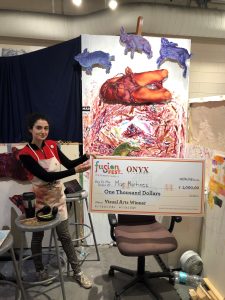
Interdisciplinary artist Mär Martinez followed her muse to a big win at this year’s FusionFest multicultural festival, receiving the $1,000 grand prize in the event’s Visual Art competition. Martinez is a studio art and art history double major.
“I was absolutely thrilled to be the recipient of the Fusion Best in Show Visual Art Award! It was a huge honor to accept the award while representing Syrian artists. I am half Syrian and half Cuban. Both cultures are equally important to my upbringing but I am closely aligned with my Middle Eastern heritage.
I was born in New Mexico but moved to the St. Pete area with my family; St. Pete values the humanities and I credit proximity to institutions like the Museum of Fine Arts, the Morean Arts Center, the Dunedin Fine Arts Center and the Dali Museum as crucial resources that fostered my interest in the arts. I attended college in Lakeland but transferred to the University of Central Florida because of its access to a larger database of artistic and cultural resources. There is more opportunity for an emerging artist here because of CityArts, the Orlando Museum of Art, the Dr. Phillips Center, etc….The art scene is more active and therefore there is opportunity to grow, especially when the city has a multitude of diverse influences from different cultures.
Orlando values diversity; Fusion Fest is a prime example of the desire to open a dialogue where all voices can exist within the conversation. The festival was an explosion of color, sound and smells! I enjoyed seeing the creativity of the city expressed through food, clothing, performance, and visual art. There were a lot of very talented artists representing their heritage, and I am proud to have participated. I displayed Aboudaken and Teta in the Onyx Gallery.
My work explores systematic power dynamics that breed dominance and aggression based on gender, ethnicity, and sexual identity within our society. Historically it has been very difficult for women, especially minority women, to access autonomy and freedom of expression within both Western and Middle Eastern cultures. There are rigid expectations enforced upon Arab women from both sides; the feminine body & associated rights from reproductive to aesthetic presentation has added constraints. The continuing power struggle for dominance is exacerbated through the body politics.
The hand-cutting of the pieces is a crucial part of my process. The violent act of stripping figures from their context mimics how power can be given and taken away. The figures become vulnerable, naked objects in the outside world. The sculptural paintings mimic the reduction of figures to objects; they’re removed from the protection of canvas, leaving figures exposed. The bodies interact within the space they’re allowed to between the pressures from both modern cultures’ expectations. My current work continues to explore the subversive channels that women access power and autonomy.
Power dynamics within the home are nuanced; the home is typically considered a “female” sphere because of the culturally enforced gender roles. Domesticity implies the female domain, but it can be a source of subversive power and many women from previous generations used it as a way to assert dominance within cultures that denied female social mobility. My Teta is a fiercely intelligent, independent and worldly woman that defied the limiting roles for Arab women of her generation, but values the home above all. She believes the home is the center of both the individual’s and the family’s strength and well being, and takes pride in nurturing the domestic sphere while simultaneously being a citizen of the world. I admire her and the positive values she has instilled into three generations of Syrian people.”